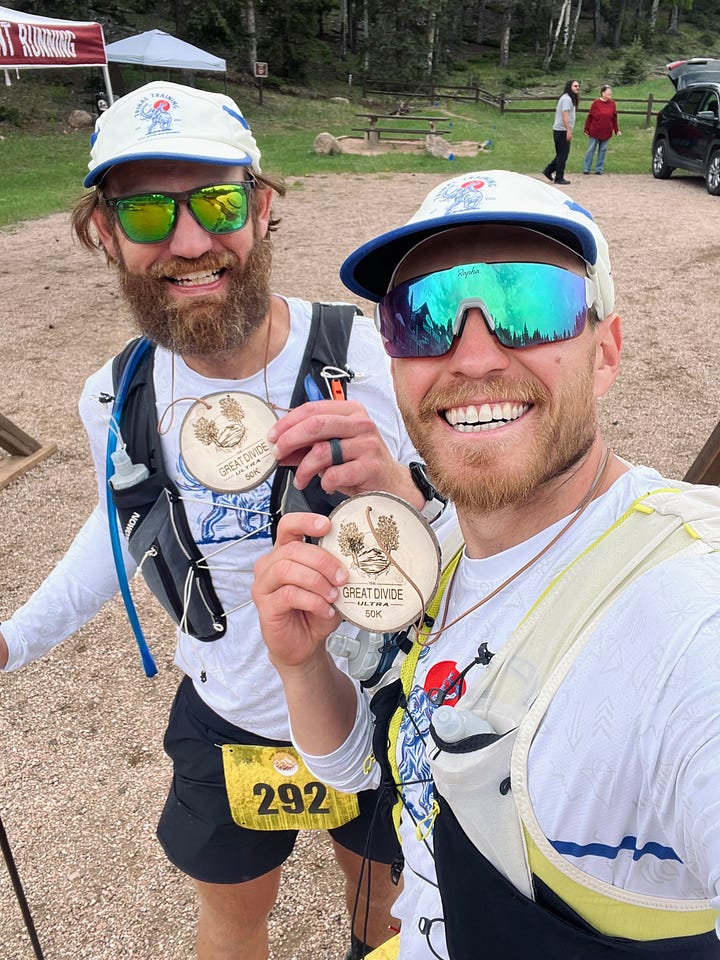Most people think an ultramarathon is just a long stretch of two modes:
1. Run when you can
2. Walk when you have to
But that mindset becomes a liability deep into a race.
Why?
Because both of those movements get slower, sloppier, and harder to sustain the longer the race goes.
You start grinding. Form breaks down. Your head drops. Mindset fades.
Let's consider another approach…
Two weeks ago, I coached my athlete Ben through The Great Divide 50k.

And the biggest execution breakthrough we found?
Dynamic Movement.
We had extreme variety in the number of ways we moved forward.
What Dynamic Movement Looks Like
On uphills:
A. hike with pole drive
Focused on upper body
Poles planted behind you
Use arm strength to propel you
B. short-stride power hikes
Focused on lower body.
Fast cadence, light on the feet
Keep steps underneath the body to avoid climbing over our own hips
On flats:
A. run
If running felt smooth, we ran
B. power walk
When running felt off, we switched to aggressive power walking
Aim for sub-15 min/miles
Forward lean and intentional pole use
On descents:
A. easy jog
Used on smoother downhills to conserve energy and stay relaxed
B. opener run
When we needed a mental or physical spark, we let the legs open up and run fast
This gave different muscle groups a chance to share the load
C. downhill hike
Used poles out in front to brace impact and protect joints
Especially effective on steep technical descents
We weren’t married to any one mode of movement. We kept changing gears.
Especially when we felt fatigue setting in.
This created physical relief, but more importantly, it gave us a sense of control.
We didn’t just react to pain or fatigue…
We moved through it.
Real-Time Coaching Cues
Anytime we felt our energy slipping, I’d cue a new strategy:
“This section is rolling. But let's skip the run/walk and just power walk this whole thing.”
“This descent is long and gradual. Let's open up the legs a bit here and run.”
“This climb is steep AF. Let's just focus on short strides here. Keep your hiking cadence up.”
We turned movement into a toolkit - not a trap.
Bonus Tool: Full Body Scanning
Later in the race, Ben said his right calf was locking up.
He was cramping, frustrated, and probably thinking the calf pain would only get worse...
So I guided him through a full body scan:
“Start with your toes. Feel each one of them gripping the ground with each stride.
Then your arches... Feel them flexing fluidly. No plantar problems.
Now your ankles. Calves. Knees. Quads. Hamstrings. Glutes. Hips. Core.”
We did this out loud. And every time, something shifted.
He went from focused on pain to connected to his whole body.
The act of scanning helped him zoom out from the acute discomfort and re-engage with total-body movement.
This technique is called Soft Vigilance.
Here’s a short 5 minute video I made that expands on this further:
It works great in any long-distance endurance events. Especially long bike rides.
Final Takeaway
Ultras aren’t just about going hard and grinding.
They’re about moving with purpose and efficiency.
Dynamic Movement isn't just a pacing strategy.
It's a tool to stay in control.
When you (or your athletes) learn to rotate movement patterns with intention, you don’t just survive the race - you execute from start to finish.


Want more tips on training for ultras The Tribal Way?
Download The Ultimate Race Guide for Your First Ultramarathon.




SOFT VIGILANCE!!!!